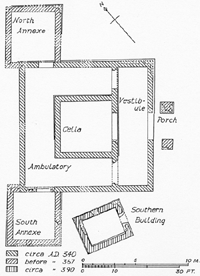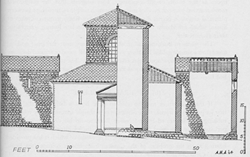
|
| A phase plan of the Brean Down temple, with ancillary buildings. (ApSimon 1965) |

|
| A phase plan of the Brean Down temple, with ancillary buildings. (ApSimon 1965: fig 50) |
Coins found during the excavation suggest that the temple was built in c. AD 340. It is of the 'Romano-Celtic' type, initially comprising a central shrine (cella) enclosed by a gallery (ambulatory) and entered from a vestibule. The external measurements of the temple were 10.5 x 10.2m. Internally the shrine was 4.8m square, the vestibule 2.8m and the ambulatory slightly narrower (a maximum of 2.7m in width). The walls were 0.5m thick. The building was floored with concrete and traces of wallplaster were found. The temple was entered from the south-east, where two plinths indicate the existence of a porch added later to the building. The bulk of the temple was constructed from limestone quarried on Brean Down. Other local stone and Bath stone was used for the architectural ornament and the structure was roofed with 'slates' of Pennant sandstone. Two annexes, to north (5.8 x 5.1m) and south (5.7x 4.9m) were added later. The reconstruction image of the temple is based on the ground plan and surviving architectural elements. The latter included voussoirs (bricks or wedge-shaped stones forming the keystones of an arch), perhaps from windows, and column fragments. A handful of Roman period images of such temples, as well as better preserved examples, have also assisted the reconstruction.
The temple had perhaps fallen into disuse by c. AD 390. The final phases saw some change in use for the site, including iron working in one of the annexes. A building erected to the south was perhaps constructed with material robbed out from the temple buildings and its occupation may have continued into the fifth century. The site of the temple, as well as other nearby parts of the down, was used as a cemetery in the post-Roman period.
previous: location and character next: deity and cult